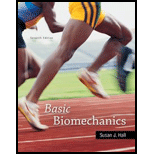
Basic Biomechanics
7th Edition
ISBN: 9780073522760
Author: Susan J Hall
Publisher: McGraw-Hill Education
expand_more
expand_more
format_list_bulleted
Concept explainers
Textbook Question
Chapter 7, Problem 6IP
INTRODUCTORY PROBLEMS
6. Explain how the use of an overhand as compared to an underhand grip affects an individual’s ability to perform a pull-up.
Expert Solution & Answer
Want to see the full answer?
Check out a sample textbook solution
Chapter 7 Solutions
Basic Biomechanics
Ch. 7 - Construct a chart listing all muscles crossing the...Ch. 7 - Prob. 2IPCh. 7 - Prob. 3IPCh. 7 - INTRODUCTORY PROBLEMS 4. List the muscles that...Ch. 7 - INTRODUCTORY PROBLEMS 5. List the muscles used as...Ch. 7 - INTRODUCTORY PROBLEMS 6. Explain how the use of an...Ch. 7 - INTRODUCTORY PROBLEMS 7. Select a familiar...Ch. 7 - 8. Using the diagram in Sample Problem 7.1 as a...Ch. 7 - 10. Solve Sample Problem 7.2 with the addition of...Ch. 7 - Identify the sequence of movements that occur at...
Ch. 7 - Which muscles are most likely to serve as agonists...Ch. 7 - Prob. 3APCh. 7 - ADDITIONAL PROBLEMS 4. Which muscles are most...Ch. 7 - Prob. 5APCh. 7 - Prob. 6APCh. 7 - 8. How much tension (Fm) must be supplied by the...Ch. 7 - 9. What is the length of the moment arm between...Ch. 7 - Prob. 10AP
Knowledge Booster
Learn more about
Need a deep-dive on the concept behind this application? Look no further. Learn more about this topic, bioengineering and related others by exploring similar questions and additional content below.Similar questions
- Which muscle pair plays a role in respiration? intertransversarii, interspinales semispinalis cervicis, semispinalis thoracis trapezius, rhomboids diaphragm, scalenearrow_forwardDescribe the structures that provide direct and indirect support for a synovial joint.arrow_forwardMovement at the shoulder joint that moves the upper limb laterally away from the body is called ________. elevation eversion abduction lateral rotationarrow_forward
- The large muscle group that attaches the leg to the pelvic girdle and produces extension of the hip joint is the ________ group. gluteal obturator adductor abductorarrow_forwardA muscle that has a pattern of fascicles running along the long axis of the muscle has which of the following fascicle arrangements? circular pennate parallel rectusarrow_forwardWhich muscle produces movement that allows you to cross your legs? the gluteus maximus the piriformis the gracilis the sartoriusarrow_forward
- The muscles of a professional sprinter are most likely to have ________. 80 percent fast-twitch muscle fibers and 20 percent slow-twitch muscle fibers 20 percent fast-twitch muscle fibers and 80 percent slow-twitch muscle fibers 50 percent fast-twitch muscle fibers and 50 percent slow-twitch muscle fibers 40 percent fast-twitch muscle fibers and 60 percent slow-twitch muscle fibersarrow_forwardFigure 38.37 Which of the following statements about muscle contraction is true? The power stroke occurs when ATP is hydrolyzed to ADP and phosphate. The power stroke occurs when ADP and phosphate dissociate from the myosin head. The power stroke occurs when ADP and phosphate dissociate from the actin active site. The power stroke occurs when Ca2+ binds the calcium head.arrow_forwardWhere is the inferior oblique muscle located? in the abdomen in the eye socket in the anterior neck in the facearrow_forward
- Which arrangement best describes a bipennate muscle? The muscle fibers feed in on an angle to a long tendon from both sides. The muscle fibers feed in on an angle to a long tendon horn all directions. The muscle fibers feed in on an angle to a long tendon horn one side. The muscle fibers on one side of a tendon feed into it at a certain angle and muscle fibers on the other side of the tendon feed into it at the opposite angle.arrow_forwardWhich of the following is not a true statement comparing exoskeletons and endoskeletons? Endoskeletons can support larger organisms Only endoskeletons can grow as an organism grows Exoskeletons provide greater protection of the internal organs Exoskeletons provide less mechanical leverage.arrow_forwardWatch this video (http://openstaxcollege.org/l/anatomical) to learn about anatomical motions. What motions involve increasing or decreasing the angle of the foot at the ankle?arrow_forward
arrow_back_ios
SEE MORE QUESTIONS
arrow_forward_ios
Recommended textbooks for you
 Principles Of Radiographic Imaging: An Art And A ...Health & NutritionISBN:9781337711067Author:Richard R. Carlton, Arlene M. Adler, Vesna BalacPublisher:Cengage Learning
Principles Of Radiographic Imaging: An Art And A ...Health & NutritionISBN:9781337711067Author:Richard R. Carlton, Arlene M. Adler, Vesna BalacPublisher:Cengage Learning Human Physiology: From Cells to Systems (MindTap ...BiologyISBN:9781285866932Author:Lauralee SherwoodPublisher:Cengage Learning
Human Physiology: From Cells to Systems (MindTap ...BiologyISBN:9781285866932Author:Lauralee SherwoodPublisher:Cengage Learning Biology 2eBiologyISBN:9781947172517Author:Matthew Douglas, Jung Choi, Mary Ann ClarkPublisher:OpenStax
Biology 2eBiologyISBN:9781947172517Author:Matthew Douglas, Jung Choi, Mary Ann ClarkPublisher:OpenStax Human Biology (MindTap Course List)BiologyISBN:9781305112100Author:Cecie Starr, Beverly McMillanPublisher:Cengage Learning
Human Biology (MindTap Course List)BiologyISBN:9781305112100Author:Cecie Starr, Beverly McMillanPublisher:Cengage Learning

Principles Of Radiographic Imaging: An Art And A ...
Health & Nutrition
ISBN:9781337711067
Author:Richard R. Carlton, Arlene M. Adler, Vesna Balac
Publisher:Cengage Learning



Human Physiology: From Cells to Systems (MindTap ...
Biology
ISBN:9781285866932
Author:Lauralee Sherwood
Publisher:Cengage Learning

Biology 2e
Biology
ISBN:9781947172517
Author:Matthew Douglas, Jung Choi, Mary Ann Clark
Publisher:OpenStax

Human Biology (MindTap Course List)
Biology
ISBN:9781305112100
Author:Cecie Starr, Beverly McMillan
Publisher:Cengage Learning
GCSE PE - ANTAGONISTIC MUSCLE ACTION - Anatomy and Physiology (Skeletal and Muscular System - 1.5); Author: igpe_complete;https://www.youtube.com/watch?v=6hm_9jQRoO4;License: Standard Youtube License